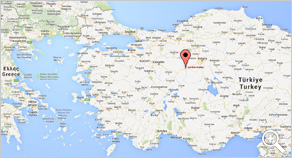GORDION

Located at the site of modern Yassıhöyük village, about 100 km southwest of Ankara in the district of Polatlı, the ancient city of Gordion was the capital of the Phrygian Empire (750-600 BC), ruling seat of King Midas. The city was built on the ruins of a Hittite city, where the ancient Persian Royal Road, major trade routes across Anatolia between Lydia and Assyria-Babylonia crossed the Sangarius (modern Sakarya) river.
The Phrygians were an ancient Iron Age people of central Anatolia. They probably came into Anatolia from southeastern Europe after the collapse of the Hittite Empire (around 1200 BC). The Phrygians settled in Gordion in the mid 9th century BC, and the city grew into the capital of a kingdom that controlled much of Asia Minor west of the river Halys during the 9th and 8th centuries BC. Adopting many of the customs and practices of their Hittite predecessors, they buried their dead in the former Hittite cemetery. The kings of Phrygia were buried in large tombs called “tumuli,” located at the outskirts of the citadel. It was the largest and richest Phrygian burial called "Midas Mound" (MM), over 50 meters in height and 300 meters in diameter; the more than 80 wooden burial chambers were covered by artificial hills. It is known that Midas was the first non-Greek to make a dedication to Apollo at Delphi, that he married a Greek princess (Pollux), and that he was the founder of Ankara (Pausanias). In Greek mythology, King Midas had the ability to turn everything he touched into gold.
In 1893 the site of Gordion was discovered when the German Classicist Alfred Körte visited a location on the Sangarios (modern Sakarya) river where engineers working on the Berlin–Baghdad Railroad had come across the remains of an ancient settlement. In 1900 Alfred and his brother Gustav carried out a short excavation. Since 1950, excavations conducted by the University of Pennsylvania and other institutions at Gordion have produced many important finds; among the most significant are the wooden objects including furniture, household objects and miniature sculptures, recovered from several tumuluses at the site. One tumulus also contained one of the oldest alphabetic inscriptions outside Phoenicia (c.740 BCE). Other characteristic Phrygian artifacts include bronze belts, wood and bronze animal figurines, and decorated pottery painted with geometric motifs or with friezes of animals. The finest objects found at Gordion are in the Anatolian Civilizations Museum in Ankara and in the Gordion Museum, which displays Early, Middle and Late Bronze age as well as Early Phrygian Period materials.
The citadel of Gordion was surrounded by an ancient wall, which dates back to the 9th or 8th century BC and was rebuilt in c. 600 BC. The Citadel’s main access was the “Phrygian Gate,” flanked by two towers. The royal palace and its associated buildings were inside a fortified enclosure within the wall.
A well-known legend related to the site is the Gordian knot, which was the name given to an intricate knot used by Gordius to secure his ox cart. Gordius, who was a poor peasant, arrived with his wife and son (the future King Midas) in a public square of Phrygia after an oracle had informed the populace that their future king would come riding in a wagon. Seeing Gordius, the people made him king. In gratitude, Gordius dedicated his ox cart to Zeus, tying it up with a peculiar knot. An oracle foretold that he who untied the knot would be the ruler of Asia, achievement made by Alexander the Great after defeating the Phrygians in the battle.
Reference: Gordion Museum (Ankara: Republic of Turkey the Ministry of Culture, 2000), sites.museum.upenn.edu
For further information about Gordion, visit: http://sites.museum.upenn.edu/gordion/
World Heritage Tentative List: Gordion
Some selected examples (please click on pictures to enlarge):








